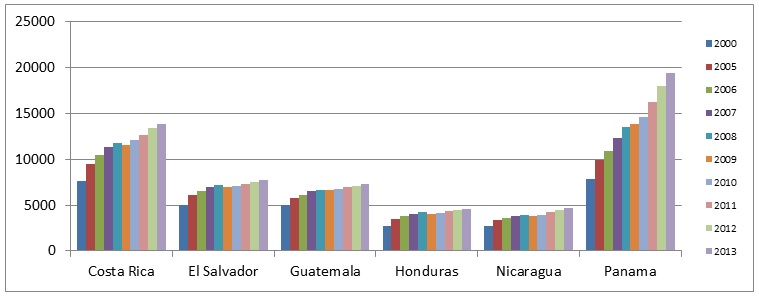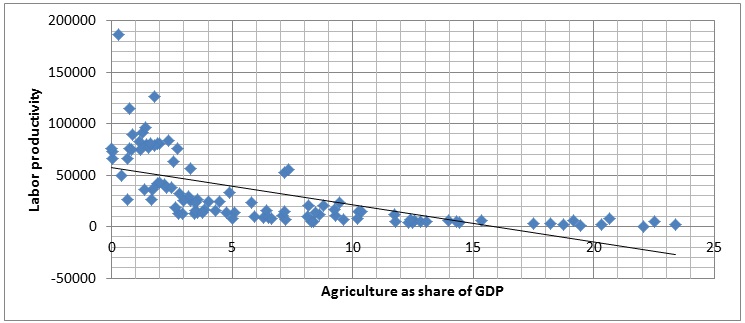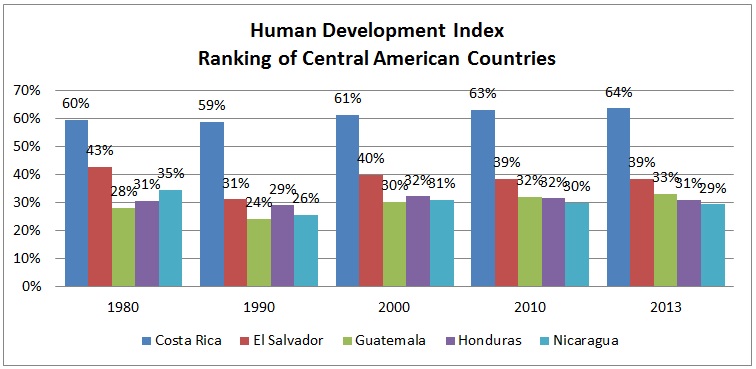Central American Economies: Development Concerns
The Central American region as a whole continues to lag behind in its economic growth and development. In fact, this region is one of the places with the lowest productivity in the world, largely due to its reliance on low-value products and low-skilled labor. GDP growth has been modest, averaging just 2-4% yearly. Meanwhile, growth in GDP per capita has lagged, particularly in Honduras and Guatemala.
Figure 1: GDP per capita, PPP (current international $)
Source: World Bank Data.
Central American economies are not only less productive, but are heavily dependent on a few sectors, such as agricultural exports, textiles and tourism, which offer limited opportunities for economic development. Countries are producing a small number of products for an even smaller number of trading partners. Even in the most developed countries, such as Costa Rica and Panama, there remains a strong dependence on a small number of exports to only a handful of trading partners.[1]
Labor markets are also a subject of concern. Workers tend to be uneducated, unskilled, and underpaid, while operating in informal markets with low yield commodities, as the table below indicates.
Table 1: Labor Force Dynamics by Country
|
Indicator |
Costa Rica (2010) |
El Salvador (2009) |
Guatemala (2006) |
Honduras (2009) |
Nicaragua (2008) |
Panama (2010) |
|
|
Labor force participation rate |
Male |
70.5 |
72.9 |
88.2 |
76.0 |
73.1 |
67.0 |
|
Female |
40.9 |
42.8 |
44.7 |
38.2 |
43.2 |
38.2 |
|
|
Unemployment rate |
Male |
6.0 |
8.9 |
1.5 |
2.6 |
5.6 |
3.7 |
|
Female |
9.5 |
4.9 |
2.4 |
4.2 |
6.8 |
6.5 |
|
|
Formality, by Sector |
Formal |
57.2 |
38.5 |
32.3 |
27.1 |
36.0 |
53.8 |
|
Informal |
41.9 |
61.5 |
65.7 |
72.9 |
63.8 |
46.0 |
|
|
Highest level of education attained, by % labor force |
None |
2.8 |
2.8 |
23.2 |
13.4 |
12.8 |
3.5 |
|
Some primary |
9.9 |
27.9 |
30.1 |
25.4 |
22.0 |
7.9 |
|
|
Complete primary |
19.2 |
22.8 |
11.1 |
20.0 |
22.7 |
22.7 |
|
|
Some secondary |
17.0 |
21.6 |
12.5 |
5.3 |
15.3 |
23.5 |
|
|
Complete Secondary |
28.4 |
12.0 |
16.3 |
28.3 |
14.8 |
17.9 |
|
|
Higher Ed. |
22.7 |
12.8 |
6.5 |
7.5 |
14.7 |
24.5 |
|
Source: ILO, Evolución de los principales indicadores del Mercado de trabajo en Centroamérica y República Dominicana, 2006-2010. 2011.
While agriculture contributes only 5-15% of GDP in the region, it is a leading source of employment. One out of every three workers in Guatemala, Honduras, and Nicaragua are employed in the agricultural sector. These are also the three countries with the highest rates of poverty (62%, 59%, and 52%), and extreme poverty (41%, 40%, and 29%).[2] When looking at households in extreme poverty, 70% of primary employment is provided by the agricultural sector.[3] As the following graphic shows, countries with strong agricultural dependence are among those with lowest labor productivity.
Figure 2: Labor Productivity and Agriculture as % of GDP
Source: Manuel Orozco.
Social indicators are also an area of great concern. Inequality in the region has not decreased since 2010.[4] Human development levels, as observed through the Human Development Index (HDI), have plateaued since the early 2000’s. The HDI rankings of Central American countries compared to the rest of the world have remained relatively stagnant since 1980. As with productivity, Nicaragua and Honduras have continually scored amongst the lowest in the world.
Figure 3: Central American Countries’ HDI, percentage ranking compared to rest of the world
Source: Human Development Indices for each country, 1980 – 2013.
High levels of crime and violence have also negatively impacted regional growth, and it may not be a coincidence that some of the slowest growing countries in the region are also among the most violent. According to Humberto Lopez, director of the World Bank’s Central America department, “beyond the effect crime and violence have on human suffering is the effect they have on profitability (…) Companies need to hire security, and there are losses associated with robbery. In some countries, particularly in El Salvador, people don’t want to work when it’s dark. High levels of crime and violence have a negative impact on the investment climate. So the economic costs of violence in these countries are huge.”[5]
Among Central Americans, there is widespread dissatisfaction and concern regarding the economy. A 2014 Latin American Public Opinion Project (LA POP) survey showed that in the majority of Central American countries, the economy was considered worse than the previous year. And recent waves of insecurity and continued poor economic performance have contributed to subsequently larger waves of emigration. Today, nearly one in every ten Central Americans lives abroad. Faced with the prospect of low-paying, low-skilled, and informal jobs, many Central Americans find it necessary to leave for better job opportunities abroad.[6]
The region’s low levels of economic growth and development constitute important challenges that deserve greater attention. For the region to address these challenges, it must find ways to strengthen its human capital and diversify its economic approach, creating better opportunities and stronger workers that can compete in the global economy.
This is part of a series of posts on Central America by the Migration, Remittances and Development Program at the Inter-American Dialogue. An upcoming book by Manuel Orozco and Julia Yansura, Centroamérica en la Mira: La migración en su relación con el desarrollo y oportunidades para el cambio (Editorial Teseo, 2015) offers more in-depth analysis of these issues.
[1] Harvard University Atlas of Economic Complexity, 2013 Data. Available at https://atlas.cid.harvard.edu/
[2] Working to End Poverty in Latin America and the Caribbean: Workers, Jobs and Wages: Banco Mundial, https://openknowledge.worldbank.org/bitstream/handle/10986/22016/9781464806858.pdf?sequence=4
[3] https://openknowledge.worldbank.org/bitstream/handle/10986/22016/9781464806858.pdf?sequence=4
[4] https://openknowledge.worldbank.org/bitstream/handle/10986/22016/9781464806858.pdf?sequence=4
[5] Humberto Lopez quoted by Larry Luxner, “World Bank Offers Encouraging Prognosis for Central America in 2015,” Tico Times, 15 December 2014. Available at https://www.ticotimes.net/2014/12/15/world-bank-offers-encouraging-prognosis-for-central-america-in-2015
[6] https://www.ilo.org/wcmsp5/groups/public/—americas/—ro-lima/—sro-san_jose/documents/publication/wcms_206030.pdf






















